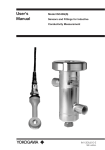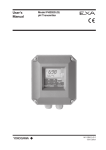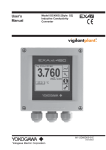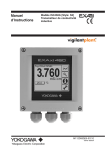Download FLXA21 Quick Start-up Manual
Transcript
FLXA21 Quick Start-up Manual This Tech Note is designed to assist with the installation of the FLXA21. This document should be used in conjunction with the User’s Manual of the FLXA21. 1. Wiring and Installation Open the cover and remove the plastic inserts covering the modules. They will be reinstalled after the wiring is completed. 1.1. Installation site The FLXA21 is weatherproof and can be installed both inside and outside. It should, however, be installed as close as possible to the sensor to avoid long cable runs between the instrument and sensor. When a pH sensor is used, the cable length including the sensor cable should not exceed 20 meters (65.6 feet); 60 meters (197 feet) when using BA10 extension box and WF10 cable. For a conductivity sensor the cable run should not exceed 60 meters (197 feet). For dissolved oxygen the sensor cable run should not exceed 30 meters (100 feet). Select an installation site that meets the following conditions. • Mechanical vibrations and shocks are negligible • No relay switch and power switch are installed close to the converter • There is space for cable connection beneath the cable glands • Not exposed to direct sunlight or severe weather conditions • Maintenance is possible • No corrosive atmosphere Select an installation site where the ambient temperature and humidity are within the limits of the instrument specifications (see chapter 2). If the instrument is installed outside and exposed to direct sunlight, a sun shade hood should be used. The Flexa can be mounted on a wall, pipe or panel when the /PM option is ordered *this is how we will keep the unit in stock*. For dimensional information please refer to section 3.5 Mounting Methods in the instruction manual. 1.2. Wiring the power supply FLXA21 is a 2-wire transmitter and can be powered by a DC power supply of max. 40 VDC. The Power Supply voltage depends on: • The load resistance: impedance of electronic equipment: typically 250 Ohm • Number of input modules: 1-sensor measurement or 2-sensor measurement. Tech Note: TNA1202 Date: February 20, 2012 One (1) Sensor module (1 input): 16 to 40 V DC (for pH/ORP, SC and DO) 17 to 40 V DC (for ISC) Two (2) Sensor modules (2 inputs): 22.8 to 40 V DC (for pH/ORP, SC and DO) The power supply is connected to the terminals marked with + and – which corresponds with the polarity of the DC power supply. The shield/ ground is connected to the terminal marked Tech Note: TNA1202 , then replace ground wiring cover. Date: February 20, 2012 1.3. Wiring the sensor The FLXA21 can be used with a wide range of commercially available sensor types, both from Yokogawa and other manufacturers. For more detailed information, refer to the respective instruction manual of the sensor. The sensor systems from Yokogawa fall into two categories; the ones that use a fixed cable and the ones with separate cables. To connect sensors with fixed cables, simply match the terminal numbers in the instrument with the identification numbers on the cable ends. The separate sensors and cables are not numbered, but instead use a color-coding system. 1.3.1. pH Measurement Conventional pH sensors are connected to the module as follows: In addition to the wiring of the sensor, insure that a jumper for low-impedance sensor inputs is installed. The jumpers can be found on the plastic sensor module cover and can be stored in the lower level module wiring cover. Tech Note: TNA1202 Date: February 20, 2012 pH Glass Electrode is a high impedance sensor input Standard reference electrodes and an ORP/REDOX electrode are low impedance sensor inputs Special electrodes using 2 glass sensor (example: Pfaudler, SC24V) do not need jumpers. Terminals 15-16 are identified as input 1 (High Impedance) and terminals 13-17 are defined as input 2 (Low Impedance). For conventional pH sensors, the jumper is placed as illustrated: 1.3.2. ORP Measurement The ORP measurement uses the same sensor input module as the pH measurement. It is not uncommon to measure ORP as process variable and a pH Glass electrode as reference. This is the case with rH measurement and with pH compensated ORP measurement. Conventional ORP sensors are connected to the module as follows: Tech Note: TNA1202 Date: February 20, 2012 For conventional ORP sensors, the jumpers are placed as illustrated: pH Compensated ORP sensors are connected to the module as follows: For pH Compensated ORP sensors, the jumper is placed as illustrated: Tech Note: TNA1202 Date: February 20, 2012 1.3.3. SC Measurement Contacting Conductivity, SC, sensors are connected to the module as follows: The above diagram shows wiring for 4-electrode conductivity sensors, such as SC42SP34 large bore series. For 2-electrode conductivity sensors, such as SC42-Sp36 small bore series, jumpers must be installed between terminals 13-14 and between terminals 15-16, as shown in the diagram below. Tech Note: TNA1202 Date: February 20, 2012 1.3.4. ISC Measurement ISC40 sensors are connected to the module as follows: The sensors are supplied with integral cables and each individual wire is marked with the corresponding terminal numbers. 1.3.5. DO Measurement The input module for DO measurement is suitable for different types of DO sensors: i. Galvanic sensors like model DO30G ii. Polarographic sensors like HAMILTON’S Oxyferm and Oxygold The connection is as follows: The DO30G sensor comes with integral cable and the wires are labeled with the corresponding terminal numbers. Tech Note: TNA1202 Date: February 20, 2012 1.3.6. Wiring of YOKOGAWA sensors Tech Note: TNA1202 Date: February 20, 2012 1.3.7. Wiring of HAMILTON sensors 1.3.8. Color coding of Variopin cables Tech Note: TNA1202 Date: February 20, 2012 NOTE: When two sensor modules are used, the upper-level module is for input 1 and the lower-level module is for input 2. For ease of installation, first wire input 2 sensor on the lower-level module (A), and attach the wiring cover; then wire input 1 sensor on the upper-level module (B) and replace the module wiring cover (C). (A) (C) (B) (D) When all wiring is completed and all covers have been installed, the front cover can be closed (D) and the power can be switched on. WARNING: When one of the modules has been removed and replaced, make sure you lock the module securely in place. Confirm that all locking-tabs (including for BLANK slots) are in “Locked” position before you close the front panel. If the locking-tabs are in “Unlock” position, the front panel may be interfered with locking-tabs. Tech Note: TNA1202 Date: February 20, 2012 2. Operation When all wiring is completed, turn on the power to the instrument. Make sure that the LCD screen turns on, and then wait for the Quick Setup menu to be displayed. Follow the on-screen instructions for set-up and calibration. If the instrument is not configured correctly an error indicator may be displayed, or the measurement values displayed may be incorrect. Consult the Instruction Manual supplied on CD with the analyzer, and check the initial settings and change them to suit your purpose. Basic operation of the software is similar the EXAxt 450 series. For more detailed information please refer to the instruction manual. 2.1. Change language The default language setting for the FLEXA is English. To select a different language other than English, follow the steps below. Tech Note: TNA1202 Date: February 20, 2012 2.2. Quick setup The Quick setup menu is used to program the basic items necessary to make the transmitter operational, such as the date/time and sensor settings. The detailed settings are described in chapter 5, Commissioning in the instruction manual. Each time the FLXA21 is started up, this menu is displayed. If it is not necessary to change the setup you may bypass the Quick setup, by selecting No or . When no operation is performed for 10 minutes, the screen changes to the main display (or home display) automatically. 2.3. Basic operation When 2 sensor modules are installed, the Home display shows both sensor information at one time, while the Main display will show the individual sensor information. If only one sensor module is installed, the is grayed out and disabled on the Main display. On the Home display, pressing the 1st sensor (top) information or the 2nd sensor (bottom) information causes the Main display of the selected sensor to appear. Home Display Tech Note: TNA1202 Main Display Date: February 20, 2012 3. Commissioning FLXA21 stores calibration data in the module(s) and in the housing assembly. After replacement of the module(s), the FLXA21 can transfer calibration data from the housing assembly’s CPU to the replaced module(s), allowing the new module(s) to be programed with the original sensor module settings. The same is true when the housing assembly has to be replaced. The FLXA21 can transfer calibration data from the module(s) to the new housing assembly’s CPU. After replacement of the module(s) or housing assembly, the unit is powered back on and the display shows the message below. 1.) If the sensor module was replaced Select [CPU->Sensor], and then calibration data is sent to the new module. 2.) If the housing was replaced Select [Sensor->CPU], and then calibration data is sent to the new housing. 3.) Select [Quit] if transfer of calibration data isn’t necessary. QUICK SET-UP NOTES: a. pH measurement module Under “measurement “a selection is made for pH, ORP or pH&ORP. The selected measurement must be in accordance with the sensor wiring. When rH measurement is requested pH&ORP must be chosen on this level. The rH must then be selected in the commissioning menu. b. SC measurement module Under “measurement” a selection is made between Conductivity, Resistivity, Concentration or Concentration plus Conductivity. On this level only Conductivity or Resistivity can be selected. Settings for Concentration measurement must be done in the commissioning menu. Tech Note: TNA1202 Date: February 20, 2012 c. DO measurement module Under “sensor type” a selection is made for Galvanic or Polarographic. The selected sensor type must be in accordance with the sensor wiring. Otherwise the analyzer or sensor can be damaged. WARNING: When a sensor input module has been changed to another measurement parameter, the FLEXA factory default must be initiated. Otherwise the FLEXA can be damaged. Commissioning>Advanced setup>Settings>Load factory settings>YES. *See TechNote TNA1201 for more information* Tech Note: TNA1202 Date: February 20, 2012














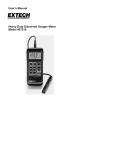


![Model SC450G [Style: S2] Conductivity](http://vs1.manualzilla.com/store/data/005772923_1-d910951678550c5451dfdc47fd4527d0-150x150.png)
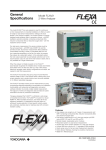
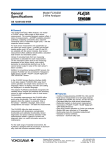
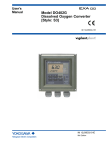

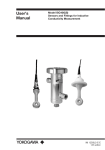

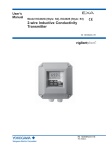
![Model ISC450G [Style: S2] Inductive Conductivity](http://vs1.manualzilla.com/store/data/005904832_1-e9e6bdf8409b6fd37a184b6e2701b530-150x150.png)
